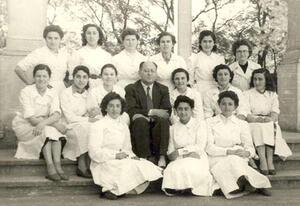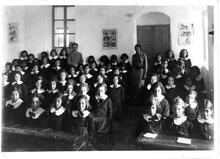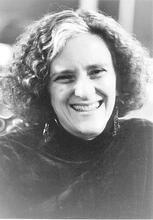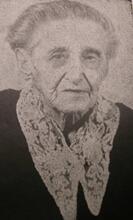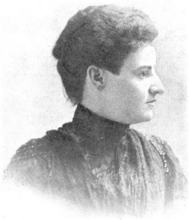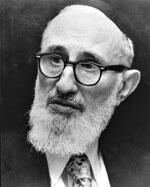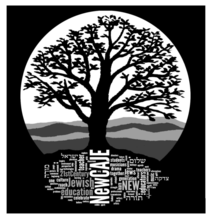Argentina: Jewish Education
The first Jewish schools in Argentina were established in the late nineteenth century in Jewish agricultural settlements. By the early twentieth century, Argentina saw the establishment of modern, secular schools offering co-educational, secular study of Jewish culture. In the 1920s, the first female teachers began to appear as a result of an increased need for preschool teachers. In the 1930s, the first religious schools opened for girls. In the 1940s, increased demand created a need to train teachers locally. By the end of the 1950s, seventy percent of teachers in Jewish schools were locally-trained women. In the 1970s, women began to fill supervisory positions on educational committees, and in 1994 the first women were ordained as rabbis in Argentina.
The First Jewish Schools: Alliance Israélite Universelle
The Jews who arrived in Argentina in the first waves of immigration at the end of the nineteenth century were as concerned about their children’s education as about earning a livelihood and organizing their community. Those who moved to the cities usually found the state education system open to all residents. Law No. 1.420 of 1884 stipulated that state education was compulsory, secular and free, and would be co-educational. However, according to established custom, perhaps due to the influence of the Catholic Church, separate schools were established for girls and boys in places where this was permitted. Despite the law, in certain districts where Jewish agricultural settlements were established under the auspices and management of the JCA (Jewish Colonization Association), founded by the Jewish philanthropist Baron Maurice de Hirsch (1831–1896), the central federal government or the provincial authorities were unable to set up schools that would provide the education obligated by law. With children of Jewish residents in danger of growing up without formal education, the JCA after some hesitation decided to establish schools for the settlements that would provide general and Jewish education in accordance with the ideology of the Alliance Israélite Universelle, where boys and girls studied together. Even after these schools were turned over to government authority in 1911, co-educational study remained the norm, perhaps because of the small number of pupils in village schools.
The teachers in the schools set up by the JCA were all men, graduates of the Alliance institutions in North Africa and Turkey and of the Ritual bathMikveh Israel agricultural school in Palestine. The JCA’s condition for granting status to the Alliance’s educational system was that all studies be conducted in Spanish (and not in French). In addition to these schools there were also traditional educational institutions on the settlements—khadorim and Lit. "study of Torah," but also the name for organizations that established religious schools, and later the specific school systems themselves, including the network of afternoon Hebrew schools in early 20th c. U.S.Talmud Torah schools in which a melammed (teacher) would teach Jewish studies only, according to the customs of the communities that had come from Eastern Europe. Usually, only boys studied in such schools.
Complementary schools of this type, which imparted only Jewish education to children who attended the government schools, also existed in the cities. Some of them, operating on the private initiative of melamdim, were established alongside synagogues of various communities: Jews of European origin and their descendants, including most of North and South American Jewry.Ashkenazim, Sephardi Jews from Turkey and the Balkans, Moroccans, and Syrian Jews from Aleppo and Damascus. These schools usually taught Jewish studies such as prayer and the Bible in Yiddish or Arabic translation, or Spanish translation in the case of the Descendants of the Jews who lived in Spain and Portugal before the explusion of 1492; primarily Jews of N. Africa, Italy, the Middle East and the Balkans.Sephardim. Usually, only boys studied in these schools. While some also accepted girls, all the teachers were men.
In 1917, with the JCA’s assistance, the Congregación Israelita de la República Argentina, the oldest Jewish organization in the country, established a national network for the support and organization of Jewish education. This was the Va’ad ha-Hinukh Ha-Roshi (Principal Education Committee), which helped all Jewish institutions, regardless of community of origin, to establish and maintain schools that operated according to the ideology of the JCA and the Alliance, teaching religious studies and stories from the Bible in Spanish, while refraining from using Yiddish. This educational committee, which supported some of the schools in Buenos Aires and almost all the schools throughout the country, provided financial subsidies, recruited teachers and supervised the work of the schools.
Secular Schools & Religious Schools
At the beginning of the twentieth century, some ideological organizations began to establish modern, secular schools in addition to the religious schools. This development was the result of a strike that the Teachers’ Association, founded in 1917, staged in a demand for better conditions of employment and modernization of the schools supported by the Principal Education Committee. The tendency towards secularization was strengthened by new teachers who arrived in Argentina after World War I in the wave of immigration from Poland and other countries west of the Soviet Union. The modern schools differed from the accepted style of the existing institutions, offering the secular study of Jewish culture, such as literature and history, to boys and girls alike. A few of them were even supported by ideological and political organizations such as Po’alei Zion, the Bund, Progressives and General Zionists. However, the structure of the schools continued to be like that of religious schools: one group of children, aged five to thirteen, with one teacher.
Until the end of the 1960s these schools, together with almost all Jewish schools, operated for two to three hours a day on five days a week. They were called “complementary” because they added Jewish education to the general compulsory education that all children received in the government schools. Because the school day in public schools was only four hours a day, in morning or afternoon shifts, the Jewish schools were able to operate during the pupils’ free time.
The first women teachers among all of those who had received their certification in Eastern Europe began to appear at the end of the 1920s. They included Sarah Fischer (1907– 1997), Sarah Nowodworski (1907–1995), Ruth Gold Kostrinsky (1907–1988), Ms. Stupnick, Rivka Shimonovich, Ziona Kandinoff, Hode Tupiash, Hanna Tenenbaum and others, who were among the first to enter the teaching profession, mostly as kindergarten teachers but also as teachers in the new schools.
While it is difficult to determine the relative proportion of women in the teaching force at the time, a 1934 account by the teachers’ union details that of eighty registered teachers, sixty-four had been certified in Eastern Europe, among them seven women teachers or kindergarten teachers. (See the accompanying picture of the teachers’ union in 1939, where men’s presence is particularly noticeable.)
The new secular schools preceded the traditional and religious schools in accepting girls as pupils and hiring women for teaching positions. Because the schools for Jews from Damascus and Aleppo were usually more conservative than the Ashkenazic ones in their education patterns and more traditionally devout, change came relatively later for them, not before the end of the 1930s.
The first non-Ashkenazic school to change in this respect was the Ha-Tikvah religious school established by the Jerusalem community of emigrants from Palestine, with the help of several activists (askanim) from Aleppo who wanted to introduce innovations into Jewish education. The establishment of this religious school was the result of an ideological and educational revolution. In 1928, the chairman of Congregation Yesod ha-Dat, comprised of immigrants from Aleppo, invited a young teacher from Palestine, Ben Zion Danieli, to teach in the community’s religious school using the “Hebrew in Hebrew” system, from a Zionist perspective, without translation into Arabic as had hitherto been customary. The community’s rabbi, Shaul Sittehon-Daba (1850–1930), who opposed Zionism and change, forbade the hiring of the young teacher and dismissed the chairman, whereupon the Jerusalem community established Ha-Tikvah with a religious Zionist perspective and with the new teacher, accepting girls as pupils, appointing an Ashkenazic woman teacher named Rivka Shimonovich, and even accepting Ashkenazic students. Ha-Tikvah soon became successful, grew to about five hundred students, and employed a second woman teacher, Ziona Kandinoff, who came to Argentina from Palestine. The opening of the religious schools to girls was accomplished by creating a special course of study for them. For example, in the 1930s, Congregation Yesod ha-Dat, under the leadership of Zionist rabbi Yosef Hai Panigel, started courses for girls in Hebrew, history, tradition and sources. These courses became part of the curriculum in 1940, with the opening of a special class with a teacher who taught Hebrew. (Out of six hundred pupils in this religious school, one hundred were girls.)
The Ashkenazic religious community followed suit, establishing a Bais Ya’akovschool for girls at the beginning of the 1940s. With the split that occurred in the religious educational camp between the Mizrachi and Agudat Israel movements at the end of the 1940s, this school remained under the sponsorship of the latter group, while the Zionists set up a class for girls which in time developed into an educational system that included teacher training. The Zionist Yitzchok Elchonon yeshiva, established by Rabbi Ya’akov Fink in 1951, numbered about twenty-five girls out of a total of some one hundred pupils.
Change in the 1930s & 1940s
The entry of women into teaching was gradual and even resulted from professional necessity, as the modern schools began to grasp the importance of nursery schools as a means of encouraging and influencing children to attend the schools. The process of opening the kindergartens was extremely slow. They required women with a special aptitude for work with pre-school pupils. The few women who had the appropriate pedagogical training from Eastern Europe were the only ones able to establish and run kindergartens. The Hebrew school in Buenos Aires, which belonged to the Zionist Union of Buenos Aires (Zionistishn Folks Farband), was apparently the first to open a kindergarten in the city at the end of the 1920s. It was run by Genia Jospe Kobrinsky (1906–1964), wife of Dov Kobrinsky, principal of the Hebrew school in Avellaneda. At the same time, a Hebrew kindergarten was opened in the Jewish town of Moisesville in the Province of Entre Ríos. From 1932 to 1934, it was headed by Sarah Fischer, who had arrived in Argentina in 1931 after professional training in Eastern Europe. In 1934, she returned to Buenos Aires and started the first Yiddish kindergarten of the Association of Secular Yiddish Schools (Geselshaft far Yiddishe Veltleche Shuln), which had Bundist leanings, although Fischer herself was a Zionist.
In the second half of the 1930s, the number of women teachers in secular schools continued to rise as both the Zionist and leftist non-Zionist schools began to employ women. The “Progressive” schools, which supported communism and had women party activists with no pedagogic training as teachers, hired women who underwent a brief training.
An extraordinary change in the status of women teachers took place in 1936, when Ruth Gold Kostrinsky, together with six men, was elected to the committee of the teachers’ organization, possibly as a result of the increasing number of women teachers or perhaps because of her remarkable personality.
During the second half of the 1930s and the beginning of the 1940s, the existing schools gradually began to change. For various reasons—including the renovation of their buildings and a change in their nature—the number of pupils choosing to attend these schools rose dramatically. One of the major causes of this was the establishment of an Education Committee, the Va’ad Ha-Hinukh of the Ashkenazic Hevra Kaddisha, which later became the Ashkenazic Kehilah of Buenos Aires. This Va’ad Hinukh directed the financial support of the Hevra Kaddisha to the schools, demanded ideological, structural, and curriculum changes and even guided the teachers in their work and improved their working conditions.
The construction of new buildings specifically designed for schools was a second factor of change. The first organization to take this initiative was The Central Organization of Secular Yiddish Schools (Tzentral Veltlech Yiddishe Shul Organizatzie) whose activists identified with the left Po’alei Zion movement. This organization established the Sholem Aleichem School in 1934 and dedicated its new building in 1942. With the increase in the number of pupils and the dearth of teachers from Eastern Europe due to World War II, there was now a need to train teachers locally.
The geographic changes in the professional origin of the teachers also led to a change in their gender. Teaching, among those professions available to Jews from Eastern Europe and the Mediterranean basin, was thought to be a good line of work for men, who bore the main burden of supporting their families. However, this was not so in the New World, where there were no restrictions on the trades open to them and the immigrants and their native-born children could enter professions that promised a better income and more possibilities for professional advancement. This trend, which was occurring throughout the American continent, led to women’s mass entry into teaching.
Teacher Training Schools
A similar phenomenon also occurred in the field of modern Jewish education in Argentina. In 1940, the Va’ad Ha-Hinukh established a Seminar Le-Morim to train young local teachers. Though there is no list of the teachers from that time, the photograph of the seminar graduates from the 1950s illustrating this article shows a majority of women: there are two or three men, while the remaining sixteen are women. However, this was not an absolute rule in the seminar, which throughout the decades of its existence also trained many men. In contrast, only women studied in the Seminar Le-Gananot for kindergarten teachers which was established in 1944, and existed till the end of the 1990s.
Since the Sholem Aleichem School also required new teachers, its principal, Chaim Finkelsztein (1911–2000), opened an accelerated teacher training course in 1941, bringing in a group of twenty certified Jewish women teachers, graduates of the pedagogical track of the state high school. The training course that he headed concentrated on Jewish studies, since the teachers had not had the Jewish education he required for the school.
Increased entry of women into teaching also occurred in the networks established by the synagogue of the Congregación Israelita de la República Argentina. This organization sponsored the Va’ad Ha-Hinukh Ha-Roshi (Principal Education Committee), whose major activities in Jewish education began at the end of the 1930s in communities outside greater Buenos Aires. In 1945, this organization established the Institute for Jewish Studies (Makhon le-Limmudei Ha-Yahadut), to train religious functionaries and teachers from among the graduates of its schools. Religious in nature, its teachers and pupils were all men. However, it soon established an additional system for girls from the same districts. The pupils of the two institutions, which operated in the city of Buenos Aires, lived in a dormitory.
School Leadership
At the end of the 1950s, the general picture was very different from that of twenty years earlier. While the veteran teachers from Europe continued to be at the center of the educational system in Argentina, seventy percent of all teachers were locally-trained women. Men still headed the schools and held most of the teaching positions in the high schools and higher-education institutions, but natural increase and the native-born population’s specialization in advanced pedagogy gradually led to women assuming positions of responsibility. From the beginning of the 1960s, the prominent place of women in the Argentina-trained teaching force resulted in locally-trained women holding most of the teaching and pedagogical management positions in elementary and high schools.
This was not the case with leadership positions in public life, which were filled by volunteer activists. The committees that established the schools and cared for their existence were made up almost entirely of men. An exception occurred in 1925, when a group of Sephardi women organized to set up a modern kindergarten in the center of Buenos Aires. There was a kind of unwritten division in schools between the men on the committee who determined school policy and budgetary needs for expansion, and the “mothers’ committee,” which took care of everyday matters such as organizing parties and events for parents and pupils. The phenomenon of exclusively male committees was also reflected in the Board of Management of the Ashkenazic community’s Va’ad Ha-Hinukh, which comprised representatives of the community, school committees and teachers. With few exceptions, all its members from its founding in 1935 were men.
The first woman to join the professional staff of an education committee was Sarah Fischer, who was appointed trainer and supervisor of kindergarten teachers. In time, especially beginning in the 1970s, women began to fill other supervisory positions on the educational committee in its various forms, and in 2002 a woman was appointed director.
Demographic Changes
The statistical data about the structure of the pupil population in the schools from the 1940s until today are neither uniform nor systematic. Nevertheless, they provide an indication of the number of children who attended the schools, in comparison with the total number of school-age children. At the beginning of the 1940s, fourteen percent of children attended the schools, twenty-seven percent during the 1950s, some forty-five percent during the 1960s, and about sixty percent during the 1970s. At the end of the 1960s, a change occurred when almost all the schools became day-schools and began to give both a general and a Jewish education. This change drastically reduced the dropout rate in the higher grades. At the same time, day high-schools were established, which an estimated forty-five percent of school-age students attended at the end of the 1990s. During this period, about two thirds of school-age children attended the elementary schools.
The most significant change in students’ attendance at high schools occurred following the establishment of two ORT schools that offered various vocational tracks, especially in the fields of computers, science and technology. In 1997 there were in all about 5,700 students in the Jewish high schools. Of these, approximately sixty-two percent attended the two ORT schools, twenty-five percent attended schools run by various streams, and thirteen percent attended the Orthodox religious schools (yeshivas and high schools for boys and girls). The revival of the ORT schools and their transformation from vocational schools with a few dozen students in the 1940s to two modern schools with a variety of vocations and learning possibilities, which began in the 1970s, also attracted a large number of girls. As the 1990s approached, girls comprised a third of the student body of these schools, constituting approximately thirty-nine percent of the total number of female high-school pupils. Male pupils at ORT constituted about sixty-six percent of the boys attending Jewish schools.
The numerical proportions in the student bodies of most of the high schools of various streams was the opposite: two-thirds were girls and one-third boys. In the Orthodox schools, the division between the sexes was almost equal, with the boys constituting a slight majority. The lack of continuity in systematic collection of data makes it difficult to describe the developing trends. Schools of the various streams, like ORT, attempt to design programs to attract students, offering various vocational options, but lack of published data makes it hard to define the directions of development.
To the above systems of formal education one must add the institution for rabbinical training and higher Jewish education of the Conservative Movement in Argentina, the Rabbi Marshall Meyer Seminario Rabínico Latinoamericano, which was founded at the beginning of the 1960s to train rabbis, religious functionaries and Jewish intellectuals of the movement. It also admitted women. During the 1990s, women began to be ordained in the rabbinate, a new phenomenon in Latin America. In 1994, the first women to be ordained were Margit Baumatz and Analía Bortz. In 2000, a Paraguayan woman, Sandra Kochman (b. 1970), was ordained there, followed in April 2002 by a further three women: Graciela Noemí Sribman de Grynberg, Sarina Raquel Vitas de Rosenberg, and Débora Berta Grinberg. In addition, the Conservative Movement’s Rabbinical School at the Solomon Schechter Institute in Israel has ordained an Argentinean woman, Diana Vila, and Chilean-born Claudia Kreiman. Other Latin American women are currently studying there. Perhaps the presence of women in rabbinical roles, a new phenomenon in Argentina and Latin America in general is an indication of new trends in the roles women will play in the future in the Jewish community of Argentina.
Astiz, M. F. "Jewish Acculturation: Identity Society and Schooling. Buenos Aires, Argentina (1890-1930)." In Journal of Jewish Identities, Vol 3, No. 1 (2010): 41-66.
Avni, Haim. Emanzipazia ve-Hinukh Yehudi (Emancipation and Jewish Education). Jerusalem: N.p., 1986.
Brodsky, A. “Educating Argentine Jews: Sephardim and their schools, 1920s-1960s.” In Returning to Babel: Jewish Latin American Experiences and Representations, ed. A. Ran and J. Cahan, 33-51. Leiden, Brill, 2011.
Epstein, D. "Maestros marroquíes. Estrategia educativa e integración, 1892-1920." Anuario del IEHS “Prof. Juan C. Grosso” 12 (1997): 347-369.
Laser, Mendel Meiern. Dos Yiddishe Shulvezn in Argentine (Jewish Education in Argentina). Buenos Aires: N.p., 1948.
Latin American Jewish Congress, OJI Bulletin No. 703, April 2002, www.congresojudio.org.ar
Rubel, Iaacov. Las escuelas judías argentinas (1985–1995) (Argentinean Jewish Schools, 1985–1995), Buenos Aires: Milá, 1998.
Rubel, Iaacov. “Jewish Education in Argentina.” In Jewish Education Worldwide: Cross-Cultural Perspectives, edited by H. S. Himmelfarb & S. Della Pergola, 173–200. New York: University Press of America, 1989.
Visacovsky, N. Argentinos, judíos y camaradas tras la utopía socialista. Buenos Aires: Biblos, 2017.
Zadoff, Efraim. Historia de la educación judía en Buenos Aires (1935–1957) (The History of Jewish Education in Buenos Aires, 1935–1957). Buenos Aires: Milá, 1994
Zadoff, Efraim. A Century of Argentinean Jewry: In Search of a New Model of National Identity. Institute of the World Jewish Congress, Policy Study 18 (2000).
Zadoff, Efraim. “La educación en las colonias agrícolas judías en Argentina y Eretz Israel a fines del siglo XIX” (Education in the Agricultural Jewish Settlements in Argentina and Palestine at the End of the Nineteenth Century), In Israel, Procesos y Perfiles, edited by M. E. Varela Espinosa and A. B. Pérez, 103–121. Granada: Grupo de Investigación “Estudios Judíos Contemporáneos, Universidad de Granada, 2001.
Zadoff, Efraim. “Identidad nacional y social judía en Argentina y México, la sociedad civil, y la escuela judía” (National and Social Jewish Identity in Argentina and Mexico, Civil Society and Jewish Education). Indice: Revista de Ciencias Sociales 21 (Buenos Aires, 2001): 311–312.

